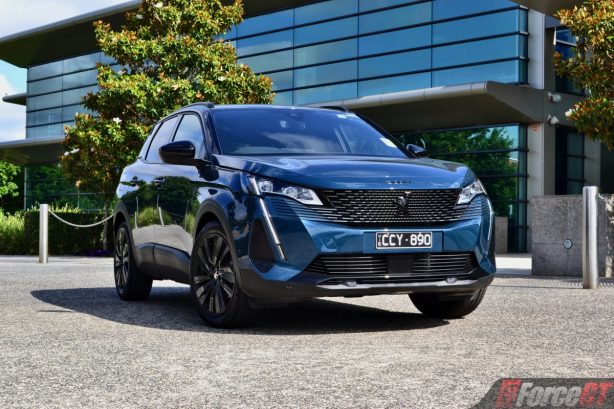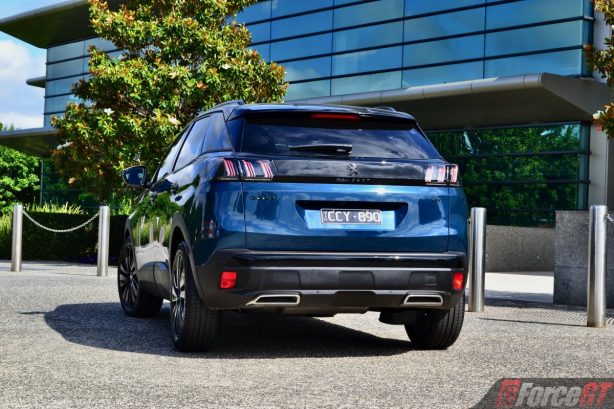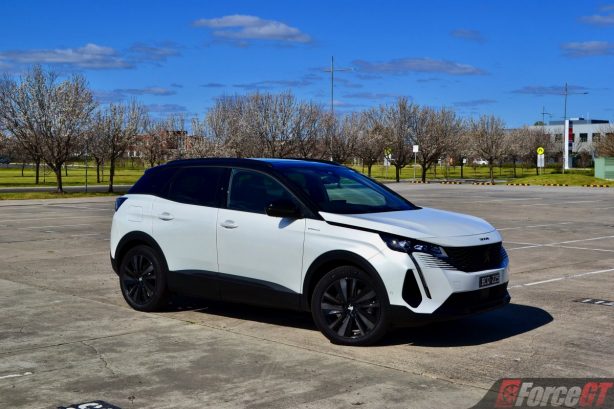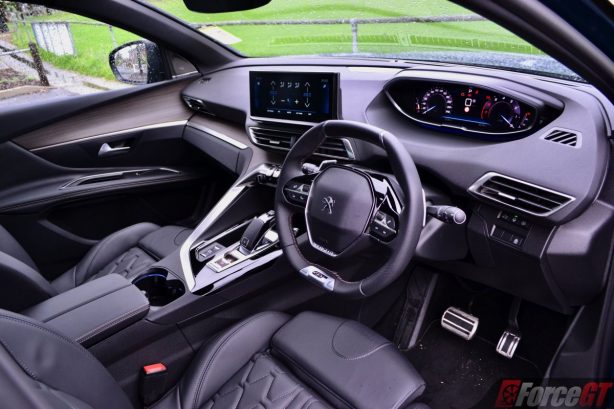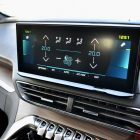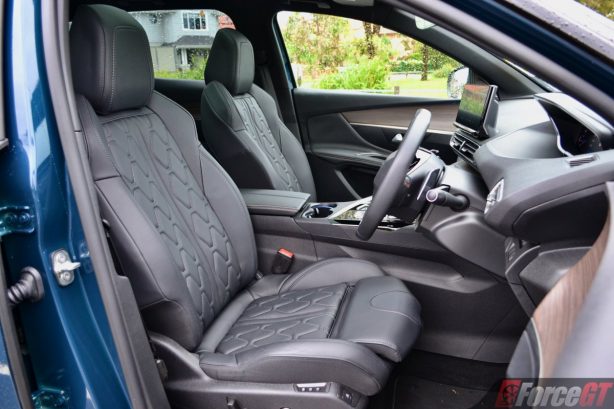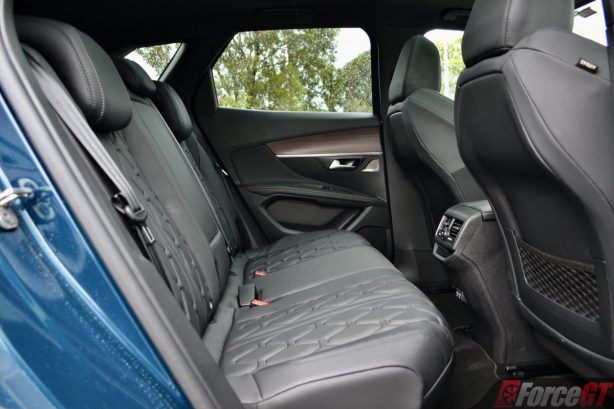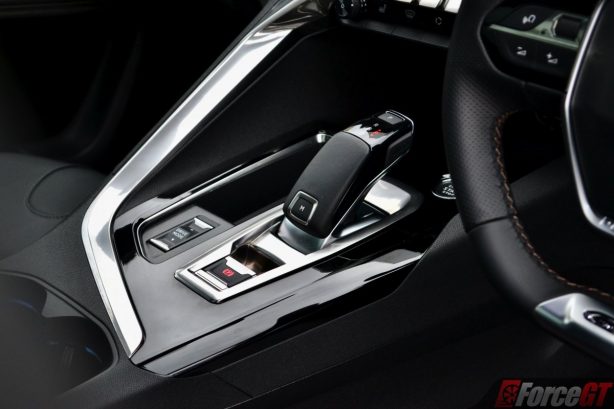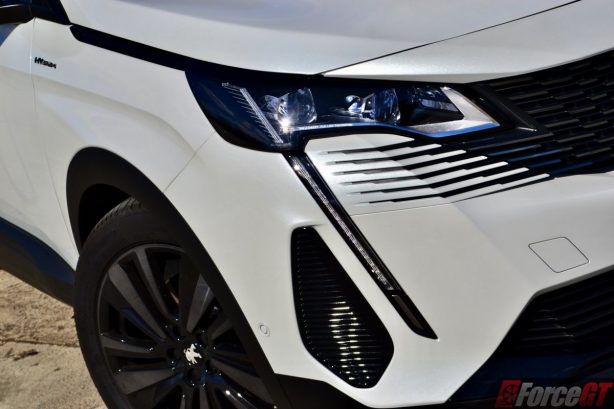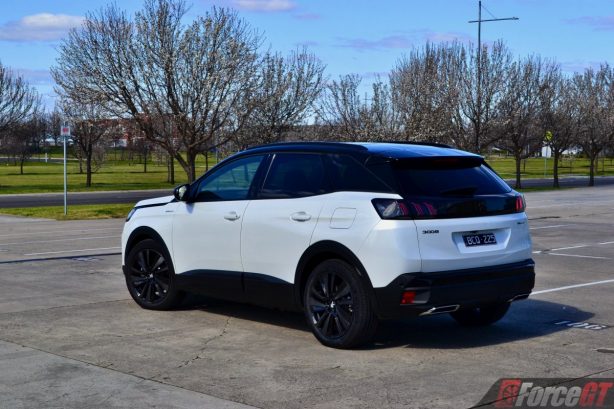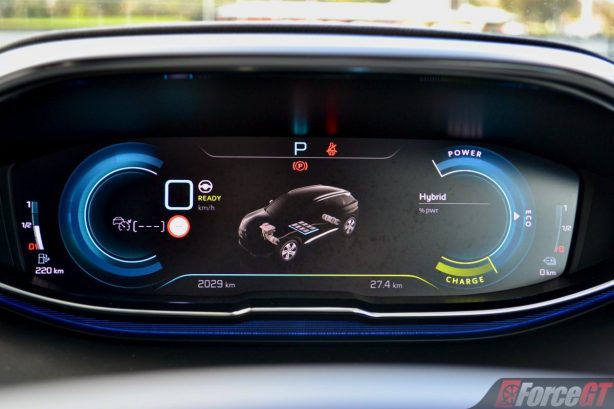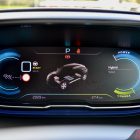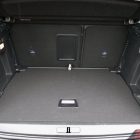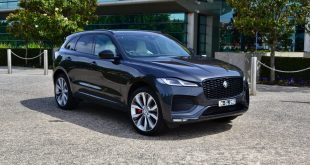Peugeot is a brand in transition. It aspires to be premium, with the main selling point being design. Indeed, there’s no denying the fact that the French brand has some of the best styling in the segment. But the keyword here is ‘aspire’, meaning the marque isn’t quite a full fledge luxury brand yet. Despite that its pricing strategy puts it well and truly in the premium territory.
Take the 2024 Peugeot 3008 for example, where the 4-tier line-up kicks off at just over $50k for the range-opening 3008 Allure trim. The top-spec GT Sport variant tested here costs $63,390 and the plug-in hybrid version is a big $20k jump to $82,915. All prices exclude on-road costs.
Those prices pit the 3008 against rivals from luxury brands like Audi and Lexus. The slightly larger Audi Q3 35 TFSI is priced at $54,600, while the more powerful Q3 40 TFSI S Line comes in at $68,400. The latter is all-wheel drive while the 3008 drives the front wheels only.
The even larger Lexus NX 250 is also within reach of 3008 money, priced at $62,275, with the NX 350h 2WD hybrid model not a far stretch at $69,050.
The BMW X1 is in the price bracket as well, with the X1 sDrive18i costing $60,400 and the X1 xDrive20i AWD priced at $70,400.
All key rivals in the mainstream space, including models like the Toyota RAV4 and Kia Sportage, are more affordable. Even the Volkswagen Tiguan R-Line which packs a potent 2.0L turbo engine and all-wheel drive is less expensive at $60,590.
But to truly understand the Peugeot 3008, one just has to take a look at it. The lion-badged medium SUV is beautifully styled with intrinsic details like the ‘claw’ LED daytime running lights and unique grille design that blends into the headlamps. They’re matched in the rear with modern taillights embedded in a back garnish.
There’re creases and lines at all the right places and a black roof that gives the SUV a sophisticated look. The proportion is spot on as well.
On the inside things are even more impressive. Premium vibe radiates from every corner of the cabin, with contemporarily styling the focus and high quality materials featured throughout. Everything from the compact steering wheel and gear shifter to the air vents and piano buttons on the centre console have been tastefully designed. Some look and feel even more delicate than those we see in luxury cars. There’re mood lighting strips in the door cards too, which set the tone at night.
Being French, there’re of course quirky elements such as the instrumentation binnacle which sits high up in the dashboard and is meant to be viewed from above the steering wheel, not through it. It’s called the Peugeot i-Cockpit which can take a bit of getting used to but we don’t find an issue with it.
No doubt, the 3008’s design inside and out is a knockout. But is that enough to justify that hefty price tag? We have to dive deeper.
From the surface it looks like the 3008 has got all the tech covered, at least in the GT Sport trim. There’s a crisp and relatively intuitive 10.0-inch centre touchscreen infotainment system featuring built-in navigation and supporting Android Auto and Apple CarPlay connectivity. However, the latter is still wired only when most of the competition have now gone wireless.
Complimenting the reversing camera is the surround view which gives a handy ‘bird’s eye’ view of the car from above, but this feature has never worked properly during our test period as there’re always greyed out sections of the car’s surroundings.
If you’re looking for a wireless phone charger, unfortunately this is nowhere to be found in the 3008. At this price point that’s a big missed opportunity, given most key rivals now have this feature as standard.
The GT Sport grades, however, do come with a pretty punchy 690 watt Focal premium sound system with 10 speakers including a subwoofer.
In terms of comfort, the 3008 fairs much better. The Nappa leather upholstered seats not only look great but also feel supple and supportive. From GT grade and up, the driver seat also features a massaging function with the option of five different massaging styles of varying intensity. Now that’s one very luxurious inclusion that you won’t even find in many luxury cars.
Rear seat space is decent for its class with good head and legroom, though the rear bench’s lack of width means three adults can get overly intimate in the back. The fitment of rear air vents will at least keep them comfortably cooled or heated.
It doesn’t disappoint when it comes to storage and convenience, either. The door pockets are usefully thick and deep, they’re also nicely padded for an added touch of luxury. A pair of decent size cupholders are fitted both in the front and back. Elsewhere, the centre console storage compartment is so massive it can swallow a 2L bottle, but the glove box is painfully tiny.
With 591 litres of cargo space (1670 litres with the seats folded, 1608 litres for 3008 PHEV), the 3008’s boot is surprisingly voluminous given the compact exterior dimensions of the SUV.
The 3008 GT Sport we drove is powered by a 1.6-litre turbocharged four-cylinder petrol engine that develops 133kW and 250Nm, the latter arriving at just 1650rpm. It drives the front wheels via an 8-speed automatic transmission. On paper the engine is less powerful than rivalling turbo petrol engines such as that in the Mazda CX-5 or Honda CR-V. However, the front-drive only Peugeot weighs considerably less than its all-wheel drive rivals and so the powertrain still feels relatively relaxed and effortless in most proceedings.
The engine is smooth and quiet for the most part and the torque converter automatic is just as fluid. Left to its own devices, the auto also works discretely in the background without once bringing attention to itself. Despite power going to the front wheels only, traction off the line is pretty good, too, a testament to its effective power management and delivery algorithm.
We also spent some time behind the wheel of the 3008 GT Sport PHEV which is fitted with the same 1.6-litre turbo petrol mill albeit tweaked to produce 147kW and 300Nm, paired with dual electric motors, one at the front and another at the rear, for a total output of 222kW and 520Nm.
Those are some strong figures, which when combined with an 8-speed auto and all-wheel drive, manage to dish out a 0-100km/h sprint time of 5.6 seconds. That’s hot hatch level of acceleration performance and from behind the wheel it does feel very eager and sprightly.
The combination of light weight (1429kg), a well tuned suspension and quick steering endows the 3008 with a very car-like handling, at least in the petrol GT Sport. Where other heftier, bulkier SUVs feel clumsy at the turn of the wheel, the Peugeot stays diligently faithful to driver inputs. Its relatively flat posture around corners further instil confidence.
The 3008 PHEV weighs a lot more at 1840kg due to its drive battery and electric motors, which blunts handling and dynamics slightly despite it being quicker in a straight line.
Ultimately though, a family car like the 3008 needs to be comfortable around town and on that front the Peugeot delivers. The ride is mostly compliant and smooth, with only the nastiest potholes or undulation able to unsettle the car. And when that happens, it’s also less severe and intruding than we’ve experienced in some other rivals.
Road and wind noise is generally well suppressed, which only allows that wonderful cabin to be better enjoyed. The feel good factor is certainly when cruising in the 3008.
Fuel economy on the combined average is rated at 5.6L/100km for the 3008 petrol, but that’s a little optimistic. Expect the figure to hover around 7.5L/100km in the real world, like how we managed after around 400km of mixed driving. It’s still a reasonable figure for a medium size family SUV, just be mindful that it chews on the more expensive RON95 premium unleaded fuel.
The 3008 PHEV is good for 60 km of electric-only driving range, but again that’s a lot more than the 45-50km that you’ll get realistically. For the average owner, this means the 3008 PHEV will require charging more often than they’d like. And it doesn’t help when it has a miserable 3.7kWh charging capacity. Topping up the battery will take close to 4 hours. It also won’t benefit from the many high capacity public charge points, leaving the only practical way to charge the car is at home overnight.
If you do tap into engine power often (hybrid driving) you’ll be looking at a combined average fuel consumption of around 2.5L/100km, that’s against the claimed 1.6L/100km figure.
On the safety front the top-spec GT Sport variants are comprehensively equipped with features like Autonomous Emergency Braking with pedestrian and cyclist detection, Blind Spot Monitoring, Lane Keep Assist and Hill Descent Control. Other driving aids include Driver Attention Monitoring, Traffic Sign Recognition, Auto High-beam, Tyre Pressure Sensor and Adaptive Cruise Control with Stop and Go function.
Verdict
Design & Comfort
Performance & Handling
Quality
Economy
Equipment & Features
OUR SCORE
3.9/5
+ Plus
- Excellent ride and handling balance
- Bold styling
- Upmarket interior
- Eager and efficient powertrain
– Minus
- Hefty price tag for a Peugeot
- No wireless charger and powered tailgate
- Buggy top down view camera
Overall
The medium SUV segment isn’t just the most popular passenger car segment in Australia, it’s also the most competitive. The Peugeot 3008 certainly stands out with its bold styling inside and out. It’s also not just a pretty face, as it’s got the performance, efficiency and practicality to back the good looks. It’s one of the nicest SUVs to sit in and drive around.
That said, there’s also no shortage of impressive rivals in the mainstream class, all of them undercut the Peugeot 3008 in price. And if the 3008 is priced to play in the premium space, which it is, the lion badge just isn’t quite there yet in terms of prestige.
This all means that the 3008 is a bit of a loner, costing too much to the average mainstream shopper while not having enough badge-cred to entice luxury buyers. But if that doesn’t bother you, there’s a lot to like about the 3008 indeed.
2024 Peugeot 3008 GT Sport pricing and specifications
| Price (excluding on-road costs): | From: $63,390 GT Sport Petrol: $63,390 GT Sport PHEV: $82,915 |
| Warranty: | 5 years/unlimited kilometre |
| Warranty Customer Assistance: | 5 year roadside |
| Service Intervals: | 12 months/20,000km |
| Country of Origin: | France |
| Engine: | GT Sport Petrol 1.6-litre turbocharged in-line 4-cylinder, direct injection petrol: 133kW @ 5,500rpm, 250Nm @ 1,650rpm GT Sport PHEV: 1.6-litre turbocharged in-line 4-cylinder, direct injection petrol, dual electric motors: 222kW, 520Nm |
| Transmission: | 8-speed torque converter automatic |
| Drivetrain: | Front-wheel drive (Petrol) All-wheel drive (PHEV) |
| Power-to-Weight Ratio (W/kg): | Petrol: 95.2, PHEV: 122.3 |
| 0-100km/h (seconds): | Petrol: 8.8, PHEV: 5.9 |
| Combined Fuel Consumption (L/100km): | Petrol: Claimed: 5.6/Tested: 7.5 PHEV: Claimed: 1.6/Tested: 4.3 |
| RON Rating: | 95 |
| Fuel Capacity (L): | Petrol: 53, PHEV: 43 |
| Body: | 5-door SUV, 5 seats |
| Safety: | 5-star ANCAP, 6 airbags (front, front side, curtain), AEB with pedestrian and cyclist detection, ABS, EBD, BA, ESP, Blind Spot Monitoring, Lane Departure Warning, Lane-keep Assist, Lane Positioning Assist, Road Edge Detection, Automatic High-Beam, Front and rear Parking Sensors, Tyre Pressure Monitoring System, 360-degree camera, ISOFIX |
| Dimensions (L/W/H/W-B): | 4,447/1,841/1,623/2,675 |
| Boot Space (min/max) (L): | Petrol: 591/1,670, PHEV: 591/1,608 |
| Ground Clearance: | 219 |
| Kerb Weight (kg): | Petrol: 1,397, PHEV: 1840 |
| Towing Capacity (kg): | Braked: 1,550 (PHEV: 1250)/Unbraked: 750 |
| Entertainment: | 10.0-inch colour touchscreen, satellite navigation, AM/FM/DAB+, Bluetooth, Apple CarPlay, Android Auto, USB, AUX, iPod, 10-speaker Premium sound system |
 ForceGT.com Car News, Car Reviews, Video Reviews, Tuning and much more.
ForceGT.com Car News, Car Reviews, Video Reviews, Tuning and much more. 